
| Home | About |
| Originally published in Army History magazine, Spring 2003, and presented here with permission of the author. | |||
Devil Dogs in Olive Drab |
|||
The 2d Engineers at Belleau Wood |
|||
| By William T. Anderson | |||
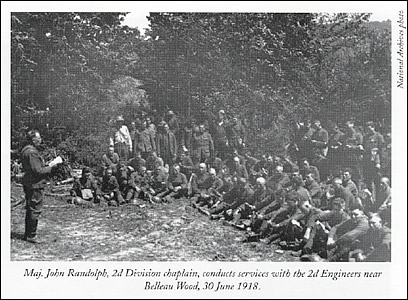
In the Marine Corps' Hall of Heroes, there are few more revered than those stalwarts of the 4th Marine Brigade, 2d Division, American Expeditionary Forces (A.E.F.). The names of the young Marine officers who struggled in Belleau Wood read like a "Who's Who" of the great combat leaders of the Marines' amphibious campaigns in World War II. However, often lost in the Marine mythology are the significant sacrifices made by the soldiers of the U.S. Army who were attached to the 4th Marine Brigade in the hot, dusty days of June 1918. The purpose of this article is to highlight the important contributions of the 2d Division's engineers, the 2d Engineer Regiment, in this bloody contest in June 1918. With shovel and '03 Springfield, the 2d Engineers fought side-by-side with the "devil dogs" of the 4th Marine Brigade.1 As then-Marine Capt. John Thomason reported in his 1926 classic Fix Bayonets. "There was always good feelings between the Marines of the 2d Division and the Regular Army units that formed it. but the Marines and the 2d Engineers—'Say, if l ever got a drink, a 2d Engineer can have half of it!—Boy, they dig trenches and mend roads all night. and they fight all day!"2 The Allies were not expecting the Germans to launch in the spring of 1918 an attack against the French on the Aisne front between Noyon and Reims, an area that had witnessed a devastatingly futile French attack the previous year. Nevertheless, on 27 May 1918 the German Army launched there the third phase of its spring offensive to defeat the Allies, and within four days the Germans were at the banks of the Marne River. Assaulting over a thirty mile front, they drove over the Chemin-des-Dames ridge and quickly exceeded their High Command's expectations. On the 29th they captured the important railroad town of Soissons and began to exploit their success, pressing ever closer to Paris. The result was the demoralization of the Allies and the creation of a third great bulge or salient in the Allied line in the shape of a triangle formed by Reims in the east, Chateau-Thierry in the south center, and Soissons to the north. Everything seemed to be moving in Germany's favor. Unfortunately for the Germans, however, the speed of the advance had outrun their logistics, and their exhausted troops were about to meet the Americans, including the 2d Engineers.3 |
|||
The 2d Engineer Regiment had been formed in July and August 1916 from the 2d Battalion of Engineers while most of the unit was participating in Brig. Gen. John Pershing's Punitive Expedition into Mexico. The unit remained in Mexico until February 1917, but after the United States declared war on Germany the regiment began training in earnest for the difficult tasks associated with trench warfare. The first portion of the regiment's journey to France started at El Paso, Texas on 22 August 1917, when it embarked by rail for Washington, D.C., under the command of Col. James F. McIndoe, a man who had ranked fourth in his class upon his graduation from the US. Military Academy in 1891. It was on the grounds of the American University in Washington that the regiment was outfitted for further duty in France.4 The 2d Engineers sailed for Great Britain on 10 September 1917 and then proceeded to France. The regiment was initially employed building troop accommodations near Nancy in eastern France for the anticipated arrival of many thousands of American soldiers. During January and February it engaged in intensive infantry and engineer troop training with the 2d Division a few miles south of where it had been pursuing construction work. |
|||
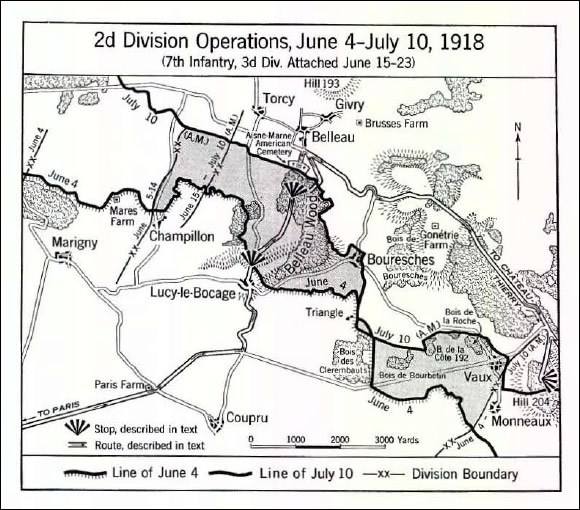
In March its regimental headquarters and 2d Battalion moved into the defensive line with the 2d Division southeast of Verdun, while the 1st Battalion joined the 1st Division in a sector north of Toul not far away. The regiment was reunited in the 2d Division area in mid-May 1918. Prior to the German attack in the Aisne sector, the division headed toward the part of the line further north near Amiens, where the Germans had advanced against the British earlier in the spring.5 Many have told the story of the 2d Division reversing its course and traveling to Belleau Wood in the final days of May 1918. They described the long convoy of "camions" or trucks that snaked along the Paris-Metz highway from Meaux to Montreuil-aux-Lions, where many members of the division commenced their foot march to the front. Initially, it had been planned to hold the engineer regiment in division reserve at Montreuil-aux-Lions, but as events turned out, it did not stay there very long. Ordered to support the French units to the west of Château-Thierry, the 2d Division commander assigned the 1st Battalion of the 2d Engineers to the 3d Infantry Brigade, his Army infantry element that comprised the 9th and 23d Infantry Regiments, and the 2d Battalion, 2d Engineers, to the 4th Marine Brigade, consisting of the 5th and 6th Marine Regiments. The Marine brigade, which was led by Army Brig. Gen. James G. Harbord, was assigned the area running generally from Les Mares Farm on the left through Lucy-le-Bocage to Triangle Farm on the right. The two battalions were supposed to be used only to perform engineer duties in support of the infantry. The primary such duty was entrenching, which was often referred to as "consolidating positions." This plan for the utilization of engineer assets was quickly revised, however, and both battalions eventually participated in combat alongside the Marines.6 During the evening of 1-2 June 1918, the two engineer battalions walked from Montreuil-aux-Lions to Paris Farm, some two miles southwest of Lucy-le-Bocage, where they drew their entrenching tools. The 1st Battalion—Companies A, B, and C—then deployed to the area near La Croisette Woods in support of the 9th Infantry. The 2d Battalion—Companies D, E, and F—moved between Lucy-le-Bocage and Triangle Farm in support of the 6th Marines. However, due to darkness and lack of maps, the 2d Battalion companies did not arrive as planned. Companies D and E reached the American forward line near Triangle Farm, but Company F was in front of Lucy-le-Bocage. In the vicinity of Triangle Farm, the platoons of Company D were assigned to companies in the 6th Marines and helped to repel the German attack of 2 June.7 When they could not prepare or consolidate defensive positions for the Leathernecks, the engineers from Company D served with them in the line. They received a prompt introduction to what it meant to support the Marine brigade on what had effectively become the front line due to the defeat of the French 43d Division that had been in front of the 6th Marines. Several engineer soldiers would be recognized later for their exemplary conduct in the fighting that day and the following night. Pvts. Jefferson Holt and Charles Raffington of the battalion's medical detachment received Distinguished Service Crosses after they continually exposed themselves to severe enemy fire in order to bring aid to wounded engineers and marines. Although wounded and in great pain, 1st Sgt. Mack Byrd refused evacuation on 3 June and remained with the company commander during the battle. He was awarded the Distinguished Service Cross for his physical courage. As a result of this action and continued exemplary conduct, Byrd was later commissioned as a lieutenant.8 While the 6th Marines were defending the area around Triangle Farm, the 2d Battalion, 5th Marines, took over responsibility for repelling German assaults on the brigade's left flank. On 4 June 1918, this battalion stopped the final German attack of the offensive at Les Mares Farm, just northeast of the village of Marigny.9 |
|||
As both sides rested on 5 June, the Allies decided to attack. General Joseph Degoutte, the French XXI Corps commander, ordered a general advance to begin on 6 June with the ultimate objective of retaking Belleau Wood and the village of Bouresches just to the east. This would prove to be by far the most catastrophic day yet encountered in Marine Corps history. At its conclusion, more marines had been killed or wounded than had become casualties in all of the Corps' previous history.10 The 2d Engineer Regiment played a critical role in those bloody twenty-four hours. Unfortunately, the engineers shared both the glory and the sacrifice. Although the 2d Engineers' 1st Battalion had initially been assigned to the 3d Infantry Brigade, on 6 June it would participate with the 6th Marines in the brutal fighting for the village of Bouresches and the southern edge of Belleau Wood. Likewise, the Engineers' 2d Battalion would be bruised and battered after providing needed reinforcements to the 1st Battalion, 5th Marines, following its assault on Hill 142 north of the village of Champillon.
|
|||
As the day progressed, the remainder of the battalion and more machine guns finally reached the area and moved forward rapidly. Mixed in with these fresh Marine troops were two companies of Army engineers, Capt. Edwin Chisholm's Company D and Capt. John Costello's Company E, 2d Engineers. Placed in the line alongside the marines to help them dig in, the engineers joined in the repulse of many vigorous German counterattacks. It was here that the 2d Battalion, 2d Engineers, first exhibited the professionalism under fire that drew the admiration of the marines. The engineers established outposts and conducted patrols. In addition, they performed critical supply duties by repeatedly going to the rear and returning with water and ammunition, vital commodities that were in short supply on Hill 142.12 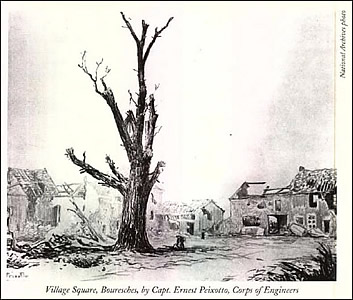
Later on 6 June, the 1st Battalion, 2d Engineers, contributed significantly to the efforts of the marines on the eastern flank of the 4th Brigade area between the villages of Lucy-le-Bocage and Bouresches. Following the costly success of the assault at Hill 142, the next phase of the operation to capture Belleau Wood began at 1700. The initial plan of the brigade directed a coordinated assault by the 3d Battalion, 5th Marines, hitting the center of Belleau Wood and the 3d Battalion, 6th Marines, striking its southern edge; both battalions would then seize the village of Bouresches and two hills just north of the village, aided by the 1st Battalion, 5th Marines, and a company from the 2d Battalion, 5th Marines. The attack of the 3d Battalion, 5th Marines, across the wheat field just north of Lucy proved to be a disastrous frontal assault over open terrain. The uncoordinated attack of the 3d Battalion, 6th Marines, into the southern edge of Belleau Wood stalled as the defenders shifted their fires to meet the threat. However, the 2d Battalion, 6th Marines, which had been ordered to aid the attack on Bouresches from its position near Triangle Farm in an amendment to the initial plan, managed to seize Bouresches. Due to the heavy casualties, the 96th Company from the 2d Battalion, 6th Marines, was only barely able to scramble into the village led by 1st Lt. James Robertson on the left and future commandant of the Marine Corps, 2d Lt. Clifton Cates, the 4th Platoon commander, on the right.13 The desperate situation in the village and at the southern edge of the woods called for engineer support by Companies A and B, 2d Engineers, that evening. As directed, the two companies left the reserve areas south of Lucy-le-Bocage on the evening of 6 June. At Lucy they were ordered to advance down the road toward Bouresches to support the 2d and 3d Battalions, 6th Marines. However, when the head of the engineer column, with Company A in the lead, was about two kilometers from Bouresches, it was swept by artillery fire, and Company B received its first casualties. Despite the enemy shelling, which included both high explosives and gas, Company A reached Bouresches at 0200, 7 June, and its platoons sought shelter where they could find it. This was a critical concern as the German artillery fire was intense during 7 June.14 Company B, evidently following its orders, meanwhile filed off to the left of the road and entered Belleau Wood. The column found a ravine15 that ran along the southern edge of the woods and followed its course until about 0230, when it encountered and joined the 3d Battalion, 6th Marines. However, a man in the 3d Platoon, Company B, lost contact near the edge of Lucy with the man he was following, causing the rest of the 3d Platoon and the entire 4th Platoon to become separated. As the road ahead came under bombardment, these men took shelter in roadside trenches and remained isolated until a guide came from their company commander. Still unlucky, this group then stumbled past the trail into the woods and continued down the road to Bouresches. Having lost two men killed and seven wounded in the bombardment, the senior officer of this reinforced platoon placed his men under the command of the senior marine in the town, Capt. Randolph Zane, commander of the 79th Company, 2d Battalion, 6th Marines, which had by now reinforced the 96th Company there. Most of these Company B men rejoined their company in Belleau Wood the following night, although a sergeant and several men became lost again, this time amid the boulders and underbrush of the woods, and they were cut off behind German lines for three days.16 |
|||
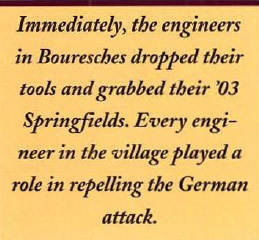
After resting most of the day on 7 June, the platoons of Company A were employed to improve the defensive positions in Bouresches. The 1st Platoon, under 1st Lt. Tucker Wyche, barricaded the street in the center of the position, while the 2d Platoon, commanded by 1st Lt. Allan Burton, built machine gun emplacements on the left flank. About twenty men from the 3d Platoon, with 2d Lt. George Woodle in the lead, improved positions on the right flank as 2d Lt. Walter Booth's 4th Platoon constructed machine gun positions covering the center of the village.17 At 0030 on 8 June the Germans began a very strong counterattack against Bouresches, supported by heavy machine gun fire from the railroad embankment outside the village. Immediately, the engineers in Bouresches dropped their tools and grabbed their '03 Springfields. Every engineer in the village played a role in repelling the German attack. Any engineers in reserve, who were not actively working when the attack began, became part of the operational reserve under Captain Zane, who used them as reinforcements or on patrols. At the height of the battle there were 110 engineers either in the front line positions in Bouresches or in Captain Zane's operational reserve there. When the Germans withdrew, the engineers surprisingly had lost no more than seven men killed or wounded.18 Company A continued to support the marines in Bouresches for the next two days,
as the town was continually shelled. It withdrew before dawn on 10 June, the day the 2d Battalion,
6th Marines, was relieved by the 3d Battalion, 5th Marines. As the engineers left, the marines
congratulated them for their courage and coolness under fire during this struggle for Bouresches.
Maj. Thomas Holcomb, the commanding officer of the 2d Battalion, 6th Marines, and another future
commandant of the Marine Corps, sent commendatory messages up the chain of command in recognition
of the company's notable contribution to the defense of the village. Singled out for recognition
were soldiers like Pvt. (later Cpl.) Louis Goodrich, who was awarded the Distinguished Service
Cross for successfully carrying the relief order from Lucy in daylight along the road to
Bouresches, which was under constant and accurate German machine gun and artillery fire.19
In Belleau Wood, those from Company B whodid not get lost prepared positions in support of the marines during 7 June as this portion of the woods was also subjected to German artillery mortar, and machine gun fire. Early on 8 June, as the Germans began their counterattack on Bouresches, they simultaneously attacked the 3d Battalion, 6th Marines, in the woods. Although the attacks were unsuccessful, Company B lost four men killed and three wounded. At 0430, the entire force was withdrawn to the ravine by which the engineers had entered the woods so that the division artillery could pulverize the enemy positions in front of them. At dawn the marines reentered the woods and attacked, supported by Company B's 1st Platoon under 1st Lt. Lester Smith. The company's 2d Platoon, under 2d Lt. James Gregory, assisted the attack by providing patrols protecting the marines' flank. This renewed attack gained little ground before it was halted at 0600, and the remainder of the day was spent consolidating positions, requiring Company B to resume digging. At dark on 8 June Company B was withdrawn from Belleau Wood and marched to a bivouac area near Marigny.20 |
|||
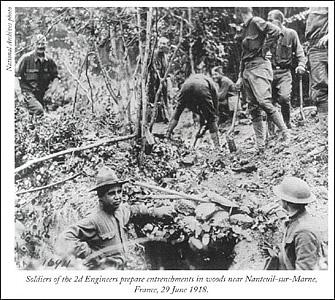
Following his brigade's failure to seize Belleau Wood on 6-8 June, General Harbord issued a new attack order on the evening of 9 June.21 It called for an attack by Maj. John Hughes's 1st Battalion, 6th Marines, into the southern portion of the woods from the ravine to the south. Due to the damage sustained in the previous American attacks and from heavy artillery bombardment, German resistance in this area was no longer at the level of effectiveness that destroyed the 3d Battalion, 5th Marines, and stymied the 3d Battalion, 6th Marines. As a result, the 1st Battalion, 6th Marines, was able to penetrate and establish positions much deeper in the woods. Then on 10 June General Harbord ordered Lt. Col. Frederic Wise's 2d Battalion, 5th Marines, to attack the northern end of Belleau Wood the following day at 0430. Taking advantage of the reduced state of the enemy, which nevertheless was still sufficiently strong to blanket the battalion's approach with deadly fire, Wise's marines fought their way into the woods. However, they were in the middle part of the woods, not the northern part. Due to the confusion of close combat in a densely wooded area, the 2d Battalion, 5th Marines, became disoriented, and Colonel Wise erroneously reported on 11 June that he and his men had reached their objective at the northern edge of the woods. As a result of this inaccurate report, Col. Wendell Neville, the commander of the
5th Marines, requested two companies of engineers to consolidate the positions at the brigade
objective. Col. Preston Brown, the chief of staff of the 2d Division, quickly sent forward two
engineer companies from the 2d Battalion to exploit this apparent success. The battalion's
commander, Maj. William Snow, led them into action.
|
|||
|
At 1700 on 12 June, Company F was ordered to move north and reinforce the 2d Battalion, 5th Marines, on their front. However, this movement proved to be disastrous, as the company came under a mixed barrage of high explosives and gas that killed the company's commander, Capt. Jesse Lowen. Many members of the company were unable to find their way through the thick woods and underbrush in their gas masks. Only 50 engineers, now commanded by 1st Lt. Harold Barrons, out of the 180 that had commenced the deployment, reached the marines. Upon their arrival, the men were immediately placed in the line facing north. Some of these engineers then joined a group of marines in capturing or killing some thirty German soldiers occupying ditches along a nearby road. Major Snow, who had been leading the company, went back to search for the missing soldiers, and although wounded in the effort, ultimately managed to reunite the company. He too was awarded the Distinguished Service Cross.23 Continuing their frontline support during repeated shelling, the engineers from both companies remained with the 2d Battalion, 5th Marines, until relieved early on 14 June by a company of the 6th Marines. The combined force of marines and engineers had reached the limit of its physical endurance. As a result of its duty with the Marine Brigade, Company D could only muster thirty men for duty on 16 June. It had lost 11 men killed or wounded; some 40 to 50 gassed; and 20 to 30 evacuated due to physical exhaustion.24 Following the withdrawal of the Marine battalions from Belleau Wood during 15-19 June, the 2d Engineers' contribution to Marine operations there ended. However, the battle continued unabated as the Army's 7th Infantry regiment relieved the exhausted marines. However, the 7th Infantry also failed to capture the woods and, beginning on 21 June, the 2d and 3d Battalions, 5th Marines, and the 3d Battalion, 6th Marines, reentered the line. Finally on 26 June 1918, General Harbord, the Marine brigade's commander, received the famous message, "BELLEAU WOODS NOW U.S. MARINE CORPS ENTIRELY."26
|
|||
The significance of the engineers' contribution at Belleau Wood was not lost on General Harbord. On 22 July 1923, some six months after he retired from the Army as a major general, the former 4th Marine Brigade commander dedicated the Belleau Wood Memorial Park next to the American Military Cemetery in Belleau, France. The Belleau Wood Memorial Association, under the sponsorship of the Navy League of the United States, had purchased the park, comprising about one-third of the entire Belleau Wood, in May 1923. (The remainder is still privately owned.) In his remarks, General Harbord noted that the former hunting preserve had become in June 1918 the focal point of a desperate struggle. Purely by chance, the world's attention was fixed on this small tangle of wildwood and giant boulders. Harbord stated that by the end of June 1918 the name Belleau Wood had been written on the tablet of history to chronicle the immortal fame of the men of the 4th Marine Brigade "and their comrades of the Second Engineers."28 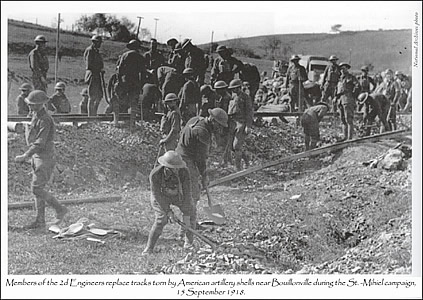
Although the advances of the increasingly exhausted German Army were in fact grinding to a halt by June 1918, most military historians affirm that the success of the U.S. 2d Division at Belleau Wood was a great stimulus to the Allied armies, which were themselves demoralized and close to exhaustion. As Cyril Falls stated in his classic account, The Great War, the "dash and daring" exhibited by the Americans in the capture of Belleau Wood was "comforting" in a month that witnessed continued German offensives elsewhere in France. Besides its strategic and operational consequences in blunting the German advance and restoring hope to the Allied cause, the fighting in the vicinity of Belleau Wood marked a noteworthy evolution in the development of the modern Marine Corps. The words and actions of I marines at this place have become important parts of the Corps' history and tradition. All should remember, however, that the success of the 4th Marine Brigade at Belleau Wood was in every sense a joint accomplishment in light of the support the 2d Engineers gave to the Marine regiments there. Indeed, this effective relationship would continue to the very end of the war, when the 1st and 2d Battalions, 5th Marines, forced their way across the Meuse River on 10 November 1218. The marines made this crossing under artillery and machine gun fire on bridging improvised by the 2d Engineers.29 |
|||
|
During the staff rides that I lead throughout the year at Belleau Wood, I always pause at the end to identify a small stone marker laid in 1919 just beyond the grounds of the American military cemetery. Although the engineer emblem it features is worn by time and weather and the marker itself needs restoration, it stands in silent tribute to the soldiers of the 2d Engineers who fought and died with the 4th Marine Brigade. They, too, earned the right to be called devil dogs. |
|||
| NOTES: | |||
|
| Last Update: 01/05/2025 1:21 AM | Web site founded 2002. | ©1917-2025 2nd Division (Regular) A.E.F. |
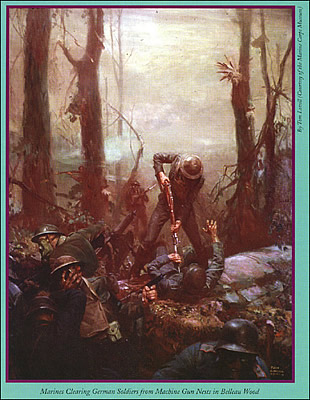
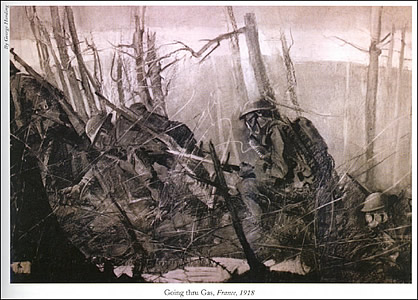
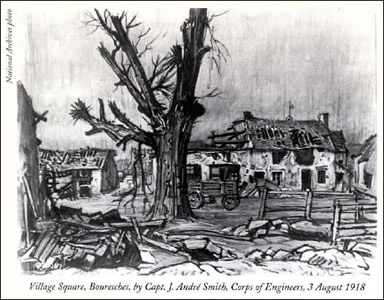
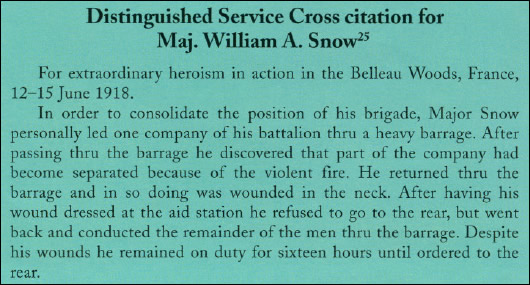 Once the companies reached the woods, however, it was quickly apparent the location of the
2d Battalion, 5th Marines, was not as reported. Company D was then directed to assist Colonel
Wise's battalion in the center of the woods, while Company F entrenched positions on the western
edge of the woods. These engineers soon experienced the thrill of supporting marines in battle when
the Germans mounted a counterattack during the evening. Company D engineers were intermingled with
the marines at every point of the action. Some platoons actually took part in raids against the
German positions. The 1st Platoon, commanded by 1st Lt. Lyman Chase, assaulted a German machine gun
position. Going into action with forty-four men, Lieutenant Chase could only count twenty-six
effectives when they left the woods. The heroism Cpl. Joseph Sanders displayed during this
fighting, combined with his bravery on 13 June when he carried a wounded officer through intense
fire to a dressing station, won him a Distinguished Service Cross.22
Once the companies reached the woods, however, it was quickly apparent the location of the
2d Battalion, 5th Marines, was not as reported. Company D was then directed to assist Colonel
Wise's battalion in the center of the woods, while Company F entrenched positions on the western
edge of the woods. These engineers soon experienced the thrill of supporting marines in battle when
the Germans mounted a counterattack during the evening. Company D engineers were intermingled with
the marines at every point of the action. Some platoons actually took part in raids against the
German positions. The 1st Platoon, commanded by 1st Lt. Lyman Chase, assaulted a German machine gun
position. Going into action with forty-four men, Lieutenant Chase could only count twenty-six
effectives when they left the woods. The heroism Cpl. Joseph Sanders displayed during this
fighting, combined with his bravery on 13 June when he carried a wounded officer through intense
fire to a dressing station, won him a Distinguished Service Cross.22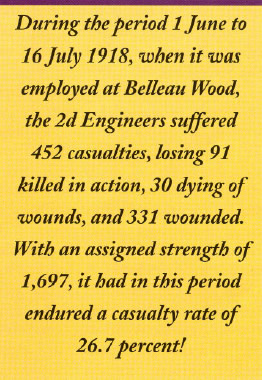 During the struggle for Belleau
Wood, the 2d Division called upon its engineers repeatedly to go forward as reinforcements either
to support Marine attacks or to assist in the defense of positions already taken. The regimental
history of the 2d Engineers states that, from the first attacks of the Marine brigade on 6 June
until the division was relieved in July, all or part of the regiment was engaged in every offensive
action. The members of the engineer regiment were very thankful for the infantry training they had
received and put that training to effective use in close combat in the tangled undergrowth of
Belleau Wood. They continued to serve valiantly for the remainder of the war. French military
authorities, with the approval of the commander of the A.E.F., General John Pershing, awarded the
2d Engineers a Croix de Guerre for its contribution to the Aisne-Marne campaign beginning on 18
July. Unfortunately, by the end of the war the regiment also earned the distinction of accumulating
the largest percentage of major casualties, 12.73 percent, of any engineer unit in the American
Expeditionary Forces. Major casualties included those who were killed in action; died of wounds,
disease, or accident; or were declared missing. These losses far exceeded the 2.65 percent average
major casualty rate for engineer units during the war, and they even exceeded by just over 1
percent the average similar losses for infantry units. The high loss figure for the 2d Engineers was consistent, however, with its service in the 2d Division, the organization that suffered the
largest number of major casualties of any organization in the A.E.F. During the period 1 June to 16
July 1918, when it was employed at Belleau Wood, the 2d Engineers suffered 452 casualties, losing
91 killed in action, 30 dying of wounds, and 331 wounded. with an assigned strength of 1,697, it
had in this period endured a casualty rate of 26.7 percent!27
During the struggle for Belleau
Wood, the 2d Division called upon its engineers repeatedly to go forward as reinforcements either
to support Marine attacks or to assist in the defense of positions already taken. The regimental
history of the 2d Engineers states that, from the first attacks of the Marine brigade on 6 June
until the division was relieved in July, all or part of the regiment was engaged in every offensive
action. The members of the engineer regiment were very thankful for the infantry training they had
received and put that training to effective use in close combat in the tangled undergrowth of
Belleau Wood. They continued to serve valiantly for the remainder of the war. French military
authorities, with the approval of the commander of the A.E.F., General John Pershing, awarded the
2d Engineers a Croix de Guerre for its contribution to the Aisne-Marne campaign beginning on 18
July. Unfortunately, by the end of the war the regiment also earned the distinction of accumulating
the largest percentage of major casualties, 12.73 percent, of any engineer unit in the American
Expeditionary Forces. Major casualties included those who were killed in action; died of wounds,
disease, or accident; or were declared missing. These losses far exceeded the 2.65 percent average
major casualty rate for engineer units during the war, and they even exceeded by just over 1
percent the average similar losses for infantry units. The high loss figure for the 2d Engineers was consistent, however, with its service in the 2d Division, the organization that suffered the
largest number of major casualties of any organization in the A.E.F. During the period 1 June to 16
July 1918, when it was employed at Belleau Wood, the 2d Engineers suffered 452 casualties, losing
91 killed in action, 30 dying of wounds, and 331 wounded. with an assigned strength of 1,697, it
had in this period endured a casualty rate of 26.7 percent!27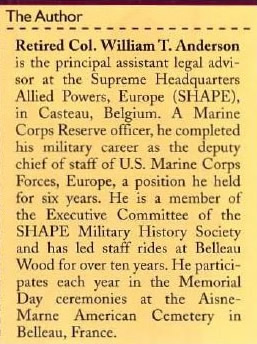 After the battle for Belleau Wood, officers in the 2d Division began to debate
the proper use of engineers.30 During that battle engineer
personnel had often been used as infantry reinforcements. This was justified as a critical
requirement under emergency circumstances. Most engineer officers concluded that their units should
be armed with French Chauchat automatic rifles, and some urged the Army to give them machine guns
as well. These proposals were rejected, however, because they would have reinforced the view that
it was correct to employ engineer troops as infantrymen, as occurred at Belleau Wood. The 2d
Division staff viewed engineers as specialized troops that should fight only if necessary, and it
did not welcome the alacrity with which the supported infantry brigade and regimental commanders
had employed the engineer assets as additional infantry in battle. The 2d Division thus adopted a
new policy of avoiding assignment of engineers to infantry units. Henceforth, the engineers were
retained under the direct control of the division commander and were only attached to an infantry
unit to accomplish a specific task.
After the battle for Belleau Wood, officers in the 2d Division began to debate
the proper use of engineers.30 During that battle engineer
personnel had often been used as infantry reinforcements. This was justified as a critical
requirement under emergency circumstances. Most engineer officers concluded that their units should
be armed with French Chauchat automatic rifles, and some urged the Army to give them machine guns
as well. These proposals were rejected, however, because they would have reinforced the view that
it was correct to employ engineer troops as infantrymen, as occurred at Belleau Wood. The 2d
Division staff viewed engineers as specialized troops that should fight only if necessary, and it
did not welcome the alacrity with which the supported infantry brigade and regimental commanders
had employed the engineer assets as additional infantry in battle. The 2d Division thus adopted a
new policy of avoiding assignment of engineers to infantry units. Henceforth, the engineers were
retained under the direct control of the division commander and were only attached to an infantry
unit to accomplish a specific task.